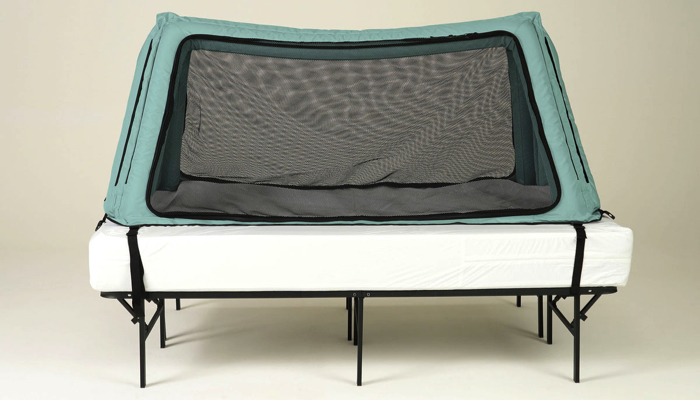Fading Sleep Training: A Gentle Approach to Baby Sleep

- Bedtime fading is the gentlest sleep training approach.
- Little to no tears are involved when you use this technique.
- The fading method relies on your baby’s natural sleeping cues and times.
- You can pick your baby up and offer them comfort when you sleep train with bedtime fading.
I’ve always been skeptical whenever I heard other moms talk about bedtime routines and training babies to sleep. If the ins and outs of well-known sleep training techniques make you uneasy as they do me, the fading bedtime approach might be your answer.
Putting your baby to bed shouldn’t drain anyone’s joy. The fading method is designed to ensure that mom and baby are happy throughout their journey to better sleep. It helps you find the perfect bedtime for your child and reduces tears and fights.
If you consistently implement this sleep training method, you’ll see results within two weeks. Bedtime fading doesn’t have many rules. This loose approach helps you find what works best for you and your baby.
What Is Fading Sleep Training?
There are several sleep training methods available to suit every parenting style. Unlike some of the others, the fading sleep training method uses a gentle approach to teaching your baby how to fall asleep independently. It involves little to no tears, and you’ll start seeing a difference in your baby’s bedtime routine within a few nights after starting.
Most babies prefer your presence when they sleep, but being there for the whole night can emotionally and physically tire you out! With the fading technique, you’ll gradually reduce how much you’re needed.
Bedtime fading is designed to identify your child’s internal clock and re-align it with your desired bedtime for them. This way, you control how late they go to bed while they feel settled and secure to do so.

How Does Fading Sleep Training Work?
Your baby can develop healthy sleeping habits with the fading method, and in time you’ll also get enough sleep to forget that you were once a sleep-deprived parent!
Before starting the fading approach, you should determine when your child naturally falls asleep. This time will be your starting point, and during the process, you can create a later or earlier bedtime for them.
After recording their natural sleep time for about five days, you should determine the best time to start their sleep routine. Stick to the time they usually fall asleep for the first few nights, even if it’s really late!
Once your baby seems to get the hang of their nighttime routine, you can start shifting their bedtime. If you want your child to sleep at an earlier time, start your routine 15 minutes before you usually would. You can move your timeline every second day until you reach a time that suits your family. Babies who fall asleep between 7 pm and 8 pm typically have a good night.
The fading technique will also help if your baby won’t sleep in their crib. During the entire process, you offer comfort to help your child learn that their sleep environment is a safe space.
Here are step-by-step instructions for two of the most successful gentle sleep training approaches that use the fading method:
Camping Out With The Fading Approach
- Get a comfortable chair and place it next to your baby’s crib.
- Place your baby in their crib, awake but drowsy, and sit with them until they fall asleep.
- If your baby fusses or cries, gently shush them with a pat to help them settle down.
- Once your child falls asleep, you can leave the room.
Move your chair away further every night, but ensure that you’re still in sight. You should get up and help your baby settle if they get incredibly fussy, but retreat to your chair when they seem to self-soothe.
With the chair method, you’ll be comfortable and close to help your baby fall asleep if they struggle. Remember to be consistent with this bedtime fading method, and resist picking your baby up from their cot unless it’s absolutely necessary.
Timed Check-Ins With The Fading Approach
- Settle your baby in their bed drowsy and leave the room.
- Only re-enter after approximately five minutes unless you hear your baby cry.
- Pat or verbally reassure your baby that you’re close by with timed check-ins.
- Once your baby sleeps, you can stop checking in every few minutes.
You should decide on an appropriate check-in time based on your baby’s age and needs. Don’t shorten or lengthen these intervals unless your baby needs you or seems okay. These check-ins work differently than those used with the Ferber method because you shouldn’t wait longer between each one.
Keeping check-ins at a five-minute interval is recommended, but you can reduce this time if your baby is still young or increase it when you’re sleep training an older toddler.
Why Does Fading Sleep Training Work?
The fading method of sleep training works because it helps sleep-deprived parents find a way to get their baby to sleep without being held and teaches needy babies to fall asleep independently without developing trauma.
Fading is one of the gentlest sleep training methods there is. Many parents choose to not sleep train out of fear that their children will have negative sleep associations. There are fewer tears with fading sleep training techniques, and children learn to form healthy sleep habits.
Benefits of Fading Sleep Training
Once you begin sleep training with the fading method, you’ll realize how many benefits this process has. Overtired babies rarely go down quickly, and this method of sleep training is designed to help you find that sweet spot where your baby naturally falls asleep.
- Positive Sleep Associations: Bedtime fading is a gentle sleep training method that will help your child sleep without crying it out. Falling asleep should be a good experience for kids, and with the bedtime fading method, you’ll help them make positive associations with their nightly routine.
- Independent Sleep: If your baby has sleep problems or can’t stay asleep while on their own, the fading method will help your child develop healthy sleep patterns and learn to be independent during the night. The fading approach uses a different method than other sleep training techniques. If your baby constantly fights against sleep, this method of sleep training will help you find their desired bedtime, making falling asleep independently an easier transition.
- Fewer Tears: If you’re against the cry it out method, you should know that the fading technique isn’t it. The fading sleep training method aims to create a positive association with sleep. The first night might involve some tears, but after keeping to a consistent bedtime routine for a few nights, you’ll see fewer tears and an improvement in your child’s sleep pattern.
- Improvement In Emotional Health: Bedtime fading will improve your and your baby’s emotional health. An overtired baby gets cranky, and if you’re emotionally drained on top of that, everything can feel like a disaster. With this baby sleep training technique, you’ll learn your child’s sleepy cues and bedtime needs to ensure that everyone gets a good night’s rest.
After surviving the first few nights, you’ll notice an improvement in your baby’s mood. Once they’ve settled into their new routine, you’ll also appreciate the earlier bedtimes and fewer wake-ups during the night.

Tips For Successful Fading Sleep Training
No sleep training method will ever be one-size-fits-all. Children fall asleep differently, and you might have to tweak the bedtime fading approach to meet your child’s needs. Many parents fail when sleep training because they forget that some rules apply. Even if you’re adjusting this method, you should keep these tips in mind for success!
Keep a Log
It’s essential to keep track of your baby’s natural sleep times even before you start bedtime fading. Once you’re ready to begin a routine, you should use these times to indicate when they’ll be the easiest to put down. Keeping a log will also help you shift their bedtime earlier or later if they naturally fall asleep at an inconvenient hour.
Learn Their Sleep Cues
Bedtime fading won’t work if your baby is overstimulated or overtired when you want them to sleep. If you catch their cues early, you can begin settling them for bed.
Time Your Start
Depending on what you include, you should start your bedtime routine at least half an hour before your baby’s natural sleep time. This routine might consist of a bath, feeding, or a book. Following a relaxed routine before you tuck your baby in will help them settle easier.
Stay Consistent
Any sleep consultant will tell you that staying consistent is key if you want the fading sleep training method to work. This is also why keeping a log of your child’s sleep pattern, and cues are important. Follow the same bedtime routine every night to help your baby learn when their time to sleep is near. You should also follow the fading approach if you’re sleep training for naps.
Offer Comfort
Unlike the cry it out method, bedtime fading encourages you to pick your baby up and offer them comfort until they settle down again. If your baby starts to fuss, you should leave them for a few seconds to see if they soothe themselves, but the moment they don’t, you can pick them up, pat their back, or shush them with a calming word or a lullaby.
Offering comfort during the process is recommended to help your baby know you’re present and improve their sense of safety. Providing comfort with the fading approach is slightly different from doing so with the pick up put down sleep training method.
If you follow these tips, your baby’s sleep training journey will be smoother, and you’ll ace it in no time!
Getting Enough Sleep with Bedtime Fading
Working with your child’s internal clock doesn’t mean they get to sleep whenever they want. The fading technique only uses their natural sleep times as a starting point to re-align their bodies.
Children need specific amounts of sleep in a 24-hour cycle to stay mentally and physically healthy. If it seems like your toddler has a natural sleep time that verges on midnight, bedtime fading will help bring this into balance.
While you’ll use this late hour as a starting point for the first few days, you can move your nights earlier once your child starts getting drowsy when the time for their bedtime routine approaches.
Bedtime fading encourages you to decide on appropriate times for your baby to go to sleep and wake up. Using this technique, you should manipulate time and move your kid’s routine earlier or later to fit in the number of sleeping hours they need each day.
FAQs
Does the fading method work?
Absolutely!
If your baby takes well to this approach and you consistently follow your nighttime routine, your baby will have an easier time falling asleep and waking less during the night.
Can I combine bedtime fading with another sleep training technique?
Every baby is unique, and combining methods from different sleep training techniques might help you find something that works better for your child. Once you’ve decided on an approach, you should keep it consistent for nighttime sleeping and daytime naps.
It’s possible to combine bedtime fading with another sleep training method but to truly experience the benefits of this approach, you need to stick to its rules.
Are there studies that support bedtime fading?
Yes.
Bedtime fading is a relatively new sleep training technique, but it’s backed by data. A study involving 21 children aged 18 months and 4 years found that approaching a nighttime routine with the fading method reduced bedtime tantrums and improved sleep quality.
Another study focused on children with autism spectrum disorder found the same and concluded that bedtime fading resulted in positive nighttime routines.
Can I start a bedtime fading routine with older children?
It’s best to start sleep training when your baby is 6 months old, but while they still can’t read their own bedside clocks, you’re safe to adjust their nighttime routine until it’s in a healthy balance with what they need.
Sleep training toddlers is sometimes easier than babies, so you shouldn’t put the fading method aside just because your kids are older.

Related Posts

Sleep, Special Needs
Safe Place Bedding Travel Bed Review
Traveling with a special needs child can be stressful! Having a safe, durable, and easy to use travel bed can make traveling so much easier!

Sleep, Special Needs
Sleep Regimen for Premature Babies: Special Considerations
It can take premature babies much longer than their full-term peers to sleep for long stretches. A preemie sleep schedule may encourage better sleep.

Sleep
Mastering the Bedtime Routine: 3 Tips for a Peaceful Night’s Sleep
From around six weeks, a newborn bedtime routine can help your baby learn the difference between day and night and prepare for a restful night’s sleep.